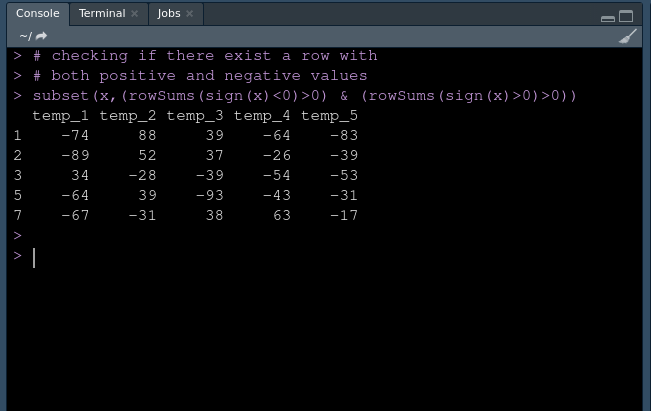R语言 从R数据框中选择同时包含正值和负值的行
在这篇文章中,我们将讨论如何在R编程语言中选择包含正值和负值的数据框中的行。为了更好地理解,让我们举一个例子。
假设你在R语言中拥有以下数据框,其中包含多列和多行。所有的行都包含负值或正值,或者可能两者都包含,如下所示。
正在使用的数据框
| ID | temp_1 | temp_2 | temp_3 | temp_4 | temp_5 |
|---|---|---|---|---|---|
| 1. | -74 | 88 | 39 | -64 | -83 |
| 2. | -89 | 52 | 37 | -26 | -39 |
| 3. | 34 | -28 | -39 | -54 | -53 |
| 4. | -82 | -19 | -64 | -33 | -20 |
| 5. | -64 | 39 | -93 | -43 | -31 |
| 6. | 92 | 86 | 44 | 23 | 82 |
| 7. | -67 | -31 | 38 | 63 | -17 |
因此,我们的任务是只选择那些同时包含正值和负值的行。选择数值后,我们的数据框应该是这样的。
预期的输出
| ID | temp_1 | temp_2 | temp_3 | temp_4 | temp_5 |
|---|---|---|---|---|---|
| 1. | -74 | 88 | 39 | -64 | -83 |
| 2. | -89 | 52 | 37 | -26 | -39 |
| 3. | 34 | -28 | -39 | -54 | -53 |
| 5. | -64 | 39 | -93 | -43 | -31 |
| 7. | -67 | -31 | 38 | 63 | -17 |
我们将从数据框中抽取一个子集,如果且仅有任何一行包含大于0和小于0的值,否则,我们将不考虑它。
语法
subset(x,(rowSums(sign(x)<0)>0) & (rowSums(sign(x)>0)>0))
这里,x是数据框的名称。
方法
- 创建数据集
- 应用subset()
- 选择同时具有负值和正值的行
- 显示这些行
例子
# To select rows in dataframe
# that contains both positive and negative values
# Creating dataset
# creating fisrs column
first <- c(-74,-89,34,-82,-64,92,-67)
# creating second column
second <- c(88,52,-28,-19,39,86,-31)
# creating third column
third <- c(39,37,-39,-64,-93,44,38)
# creating fourth column
fourth <- c(-64,-26,-54,-33,-43,23,63)
# creating fifth column
fifth <- c(-83,-39,-53,-20,-31,82,-17)
# creating dataframe
x <- data.frame(temp_1=first,
temp_2=second,temp_3=third,
temp_4=fourth,temp_5=fifth)
# checking if there exist a row with
# both positive and negative values
subset(x,(rowSums(sign(x)<0)>0) & (rowSums(sign(x)>0)>0))
输出

图1
 极客教程
极客教程